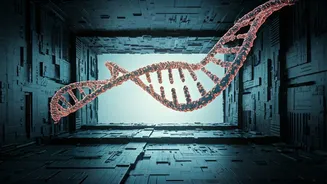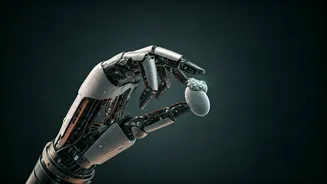DNA: Beyond Genetics
The conventional view of DNA primarily revolves around its role as the carrier of genetic information, dictating traits and predispositions within living
organisms. However, in recent years, scientists have pushed the boundaries, uncovering entirely new applications for this fundamental molecule. The extraordinary possibilities extend far beyond the realms of biology and medicine. DNA, with its unique structure and properties, is now being employed in a plethora of unexpected fields, proving itself a versatile resource for innovation. This transformation has opened up entirely new possibilities in areas like materials science, computing, and environmental conservation, turning the building blocks of life into tools for engineering, computation, and beyond.
DNA-Based Computing
Imagine computers built not from silicon, but from the very essence of life. Scientists have successfully created DNA-based computers, which leverage the information-carrying capacity of DNA strands to perform complex calculations. This innovative approach promises unparalleled data storage density and computing power, as the ability to store vast amounts of information within tiny volumes of DNA is far beyond that of traditional electronics. The basic principle involves encoding data using the four nucleotide bases of DNA (adenine, guanine, cytosine, and thymine). The computer executes its operations by manipulating these strands in a controlled manner, opening up new horizons in complex problem-solving and data analysis. This cutting-edge application may revolutionize computing.
DNA in Nanotechnology
DNA's self-assembling properties have made it a cornerstone in nanotechnology. Because of its predictable structure, DNA molecules can be designed to assemble into specific shapes and structures. Scientists can use this attribute to create incredibly small components and structures with specific designs for various applications. For example, DNA can be engineered to build molecular machines, nanoscale circuits, and drug delivery systems. The possibilities are vast, ranging from developing advanced materials to creating targeted drug delivery systems. DNA nanotechnology allows scientists to work at the molecular scale, enabling unprecedented control over materials and their properties. The ability to manipulate matter at the atomic level opens up exciting possibilities for scientific and technological innovation.
DNA for Diagnostics
DNA-based diagnostics have transformed the landscape of medical testing. Advanced techniques, like polymerase chain reaction (PCR) and DNA sequencing, now allow for rapid and accurate detection of diseases at early stages. PCR, for example, amplifies trace amounts of DNA to identify pathogens or genetic markers, enabling quick diagnosis of infections and genetic disorders. DNA sequencing allows for the analysis of the entire genome, facilitating personalized medicine, which tailors treatments based on individual genetic profiles. Early detection and precise analysis significantly improve patient outcomes and enable preventative strategies. These technologies are crucial in the fight against infectious diseases, cancers, and genetic conditions, providing doctors with more effective tools for patient care and treatment.
DNA in Forensics
The field of forensics has been revolutionized by DNA fingerprinting. This technique analyzes unique patterns in an individual's DNA to identify them with remarkable accuracy. DNA evidence has become a critical tool for solving crimes, identifying victims, and exonerating wrongly accused individuals. From crime scene investigations to paternity testing, DNA analysis provides irrefutable proof, helping to uphold justice. DNA technology can link suspects to crime scenes by comparing DNA samples from the scene with those of potential suspects, providing evidence for investigators and the courts. This has greatly enhanced the efficiency and reliability of legal systems across the world, offering a powerful tool for law enforcement and the pursuit of justice.
DNA and Data Storage
DNA possesses an extraordinary capacity for storing vast amounts of data in a compact space. Scientists are actively exploring DNA's potential as a highly durable and dense storage medium. The four bases of DNA, along with complex encoding methods, enable the storage of digital information with unparalleled efficiency. The recorded information can be retrieved, with stored data showing exceptional stability over centuries. This is an attractive prospect for long-term archiving, and it’s especially useful for the preservation of large datasets. The remarkable storage capacity of DNA makes it a strong contender for future data storage solutions, as traditional methods begin to fall behind the ever-increasing demands for information management.
DNA in Materials Science
DNA's ability to self-assemble has made it a valuable tool in materials science. By designing specific DNA sequences, researchers can create complex, nanometer-scale structures with unique properties. These structures can be used to develop innovative materials, such as conductive nanowires, sensors, and drug delivery systems. DNA-based materials are increasingly being employed in a wide array of fields, including electronics, medicine, and environmental science. Their versatility and tunability open up exciting opportunities for developing advanced materials, with properties tailor-made for specific applications, transforming the way we manufacture materials.
DNA for Environmental Cleanup
DNA has been applied to environmental challenges, where it helps with cleaning up pollutants and monitoring ecosystems. Scientists are developing biosensors that use DNA to detect the presence of contaminants, like heavy metals or pesticides, in water and soil. DNA can also be used to engineer microorganisms that break down pollutants. This approach, often called bioremediation, leverages the natural processes of these organisms to clean up contaminated environments. These advances aim to create sustainable, and environmentally friendly solutions to address pollution. DNA-based strategies can help restore ecosystems and mitigate the harmful effects of industrial activities.
DNA in Food Production
DNA technology plays a significant role in modern food production. Genetically modified organisms (GMOs) are created by inserting specific genes into plants to enhance traits like yield, disease resistance, and nutritional value. The use of DNA analysis helps in identifying and tracking food ingredients, ensuring food safety, and preventing fraud. DNA fingerprinting can trace the origins of food products, providing information about its journey from farm to table. This also enables the assessment of food quality, ensuring that it is safe for consumption. These applications help in improving food supply, which benefits both consumers and producers.
DNA and Art
Surprisingly, DNA is beginning to have a presence in the realm of art. Artists are exploring ways to incorporate DNA in their creations, pushing the boundaries of creativity. Some are using DNA-based materials to create sculptures or installations. Others are using DNA sequencing techniques to generate unique patterns and designs. This marriage of art and science showcases the diversity of DNA. These innovative experiments create novel ways of self-expression, opening up innovative experiences. This fusion exemplifies how scientific breakthroughs can influence and inspire artistic endeavors, demonstrating the limitless potential of innovation in art.










